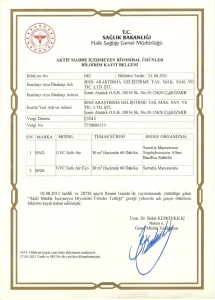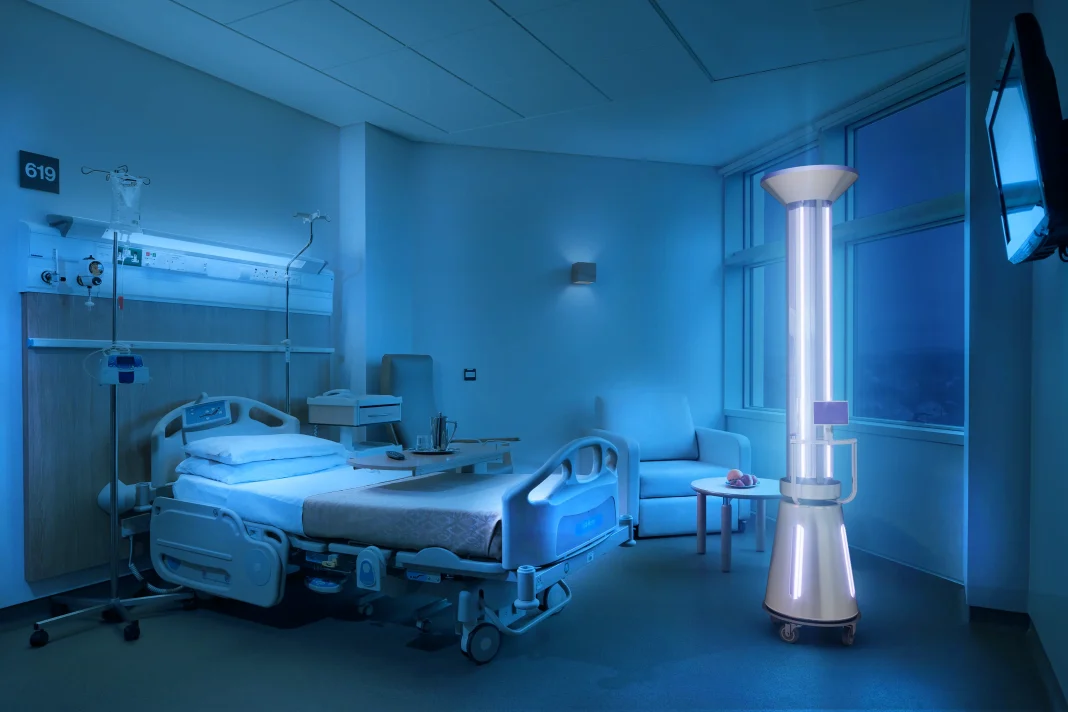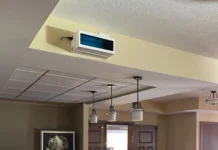Neil Avner Cikurel, RND Arastirma Gelistirme Tasarim Makine Sanayi ve Ticaret Ltd. Sti.
In March 2020, I was in the United States attending RadTech 2020 and the IUVA Americas Conference in Orlando, Florida, when the SARS-CoV-2 outbreak started to affect the entire world. My flights were canceled, and it took me three days to reach the airline company and book a flight home. It was frightening to see that even the world’s most powerful countries stumbled in containing and controlling the disease. In mid-March, World Health Organization confirmed the SARS-CoV-2 outbreak as a pandemic.
Turkey’s efforts to fight the pandemic started much earlier when the Ministry of Health set up the Coronavirus Scientific Advisory Board (hereafter, CSAB) on January 10, 2020, to work on guidelines for treatment by medicines and measures to be followed by the public. CSAB also was tasked with monitoring the disease’s course in the country and reporting back to the ministry. CSAB originally organized with 26 members specializing in chest diseases, infectious diseases and clinical microbiology. With the addition of expert academics in virology, internal medicine and intensive care medicine, the number of board members increased to 38.
The first sign that full lockdowns and limited social interaction were on the horizon came on March 12, 2020, when the press secretary announced that primary schools, middle schools and high schools in Turkey would be closed for a week, beginning on March 16, 2020. Universities also were to be closed for three weeks, and sports matches were to be played behind closed doors in stadiums until the end of April 2020. The Ministry of Interior Affairs announced a total curfew that lasted four months for those who were over the age of 65 or chronically ill. The rest is similar to the story in every country – full lockdowns for all public gathering spaces, isolation, online education, working from home, panic, rushing to supermarkets, hope for a vaccine… and a significant loss of life around the world that continues today.
All crises come with opportunities, and this was no different. The shortage in personal protective equipment (PPE), such as masks and disposable aprons, created a “gold rush” effect in Turkey. Many companies thought the only way to overcome the crisis was to produce or offer solutions addressing the needs created by the pandemic, and the number of companies offering products – despite no experience in the hygiene field – rose at an avalanche speed. Entrepreneurs established companies overnight to provide disinfection services or to design and manufacture disinfection solutions for clothing items, PPE, mobile phones, key chains, wallets, grocery bags and even for the air we breathe. Countless products flooded the market with claims of disinfecting the surfaces and/or the air but without scientific evidence, creating a hard-to-clear dust storm of misconception and misinformation.
CSAB Guidelines for Regulation of UV-C Disinfection Devices
CSAB, with the aim of protecting the public from poorly designed products and false claims, intervened on September 21, 2020. The board classified all devices claiming to disinfect surfaces, environment and air through the use of UV-C, HEPA filter, ionization or other novel technologies as biocidal products with no active substances. This classification is regulated under the Directive on Biocidal Products Without Active Substance,1 published in the Official Gazette dated August 2, 2013. The purpose of this directive is to ensure that products used for biocidal purposes in the field of public health but that do not fall under the scope of the Biocidal Products Regulation2 are not harmful to public health and the environment; thus, to make the products reach the public in a safe and high-quality manner. The Directive determines the procedures and principles of the notification to be made to the Public Health Institution of Turkey before such products can be supplied to the market, the information and documents to be found in the technical file of the product, and the market surveillance and inspection principles of these products.
The directive strictly forbids the sale and marketing of products falling into this category without approval certification (“ÇevSis” Certificate) from the Ministry of Health (Image 1). CSAB also published “Requirements for Determining the Efficiency of UV-C Devices,”3 a document that set the ground for determining the microbial efficiency of UV-C surface, environment and air disinfection equipment, as well as safety concerns that needed to be addressed. The document originally was published on September 21, 2020, and was amended on November 25, 2020, and March 24, 2021, to include HEPA filters, ionization and some of the newer technologies available on the market.
I translated the highlights of the document, originally published in Turkish, into English to the best of my abilities. The previous version of the document mandates the determination of the wavelength to ensure the UV-C source utilized emits at the claimed wavelength. Hence, wavelength measurement is not addressed in this newer version.
- Regarding the analysis method and analysis of devices that do not contain active substances, contain UV-C lamps, and disinfect the environment and air with these lamps:
a. The microbial efficiency tests for the UV-C air disinfection equipment should be carried out based on the “GB 21551.3-2010 Antibacterial and Cleaning Function for Household and Similar Electrical Appliances – Particular Requirements of Air Cleaner” standard. It is necessary to prove that the equipment can achieve at least 3 log reduction for fungus and 4 log reduction for viruses and bacteria within two hours in a 30 m3 chamber. The test report should carry the model’s name, the flow rate (m3/h) and the time required to achieve the above-mentioned reduction rates for each of the microorganisms for which the manufacturer claims efficiency.
b. Any methods utilized on the equipment other than the UV-C, and that might contribute to the reduction of the microorganisms (i.e., HEPA filters, reflective materials), should be specified in the report.
c. Cumulative ozone concentration in eight hours of operation should not exceed 0.05 ppm. The tests should be conducted according to the ASTMD 4490-96 methodology during eight hours of operation and with hourly measurement intervals. The test report should prove that the cumulative ozone concentration in eight hours of operation in a chamber of 30 m3 is below the maximum allowable limit of 0.05 ppm.
d. Products should be UV-C tight. UV-C leakage tests should be conducted according to the GB 21551.3 standard, proving that the UV-C radiation at 30 cm of all the edges of the equipment is ≤5 µw/cm2.
2. Antibacterial activity will be determined based on ISO 15714 and GB 21551 standards. Apart from the method and reference microorganisms specified in the standard, if – in the analyses made with the modification of the standards – bactericidal, virucidal and/or fungicidal claims are made by the manufacturer, the below-listed viruses, bacteria or fungi should be used respectively. If the disinfection claim is to be made, then microbiological efficacy tests should be conducted for each of the below-listed viruses, bacteria and fungi. If the equipment is to be put on the market by performing a microbiological efficacy test on only one microorganism, only that microorganism should be claimed on the product label.
a. Bactericidal Efficacy Claim: Microbiological efficacy tests should be conducted on Serratia marcescens, Staphylococcus albus and Bacillus subtilis.
b. Fungicidal Efficacy Claim: Microbiological efficacy tests should be conducted on Cladosporium sphaerospermum and Aspergillus brasiliensis (Aspergillus niger).
c. Virucidal Efficacy Claim: Microbiological efficacy tests should be conducted on Adeno virus, Bacteriophage MS2 and Vaccinia virus.
d. If an efficacy claim is to be made for a microorganism other than the above-mentioned ones (i.e., SARS-CoV-2), the microbiological efficacy test should be conducted on the microorganism subject to the claim.
3. It is not appropriate to determine the dose and to claim efficacy for untested microorganisms based on the amount of dose applied to the tested microorganisms, according to article 7.5 of the ISO 15714 standard.
4. It is not appropriate to report test results for a 30 m3 test cabin for equipment tested in smaller-volume test cabins (i.e., 2 m3) by creating a ratio between the volumes of the test cabins. The air circulation generated by the equipment in a 2 m3 cabin will not be representative of the air circulation generated in a 30 m3 test cabin.
5. Evaluation of UV-C air disinfection equipment in public transportation and passenger vehicle air conditioners or in-vehicle ventilation systems:
a. The microbiological efficacy of UV-C air disinfection equipment deployed in the air conditioning or ventilation system of public transport vehicles can be tested according to the ISO 15714:2019(E) standard. The product label and a label in a visible spot of the vehicle should state that UV-C systems are deployed to contribute to air disinfection. However, no claim for disinfection can be made for public transport vehicles.
b. However, if a disinfection claim will be made for a passenger vehicle, it must be done with the in-house test method to be developed with the modification of the GB 21551 standard test method (provided that the standard operating procedures (SOP) describing the method stages of how the in-house test methods are applied are submitted to the ministry). All the points covered in Article 1 of this consent apply to this article as well.
c. It is necessary to establish a procedure and create a declaration form regarding the wastes that may arise in case of breakage of mercury-containing lamps. The wastes should be delivered to licensed companies under the waste code for safe disposal.
d. In the event of a situation that may cause the disinfection process to be interrupted or the disinfection to stop, a visual warning should be provided and an emergency procedure should be established to ensure that the necessary precautions are taken by warning the driver.
6. The use of portable/mobile UV-C devices with open UV-C sources designed for personal use are not suitable for use for air or environment disinfection, as users might be exposed to UV-C. Only products with UV-C-tight designs and fulfilling the UV-C Leakage test on Article 1d should be used for air disinfection.
7. Evaluation of UV-C upper room air disinfection systems:
a. Upper room systems should not be used in vehicles.
b. The labels and documentation of upper room systems should state clearly: “Efficacy achieved only if there is an upward airflow in the room.”
c. To determine that there is no UV-C radiation other than the designed open radiation area, the UV-C leakage test according to GB 21551.3 tests should be conducted, proving that the UV-C radiation at 30 cm of the equipment is ≤5µw/cm2.
8. UV-C surface disinfection equipment should comply with directive 2006/25/EC and should meet the health and safety requirements. The UV-C dose, effective radiation value (Eeff) should be measured at 60 cm, 120 cm, 180 cm, 240 cm and 300 cm and limited according to daily allowable limits at the Annex-2 of the 2004 guide to “Exposure Limits of Ultraviolet Radiation in the 180-400 nm Range” from the International Commission on Non-Ionizing Radiation Protection (ICNIRP).
9. Any equipment using technology other than UV-C (i.e., HEPA filters) and claiming to purify, clean or disinfect the air is subject to the relevant tests specified in Article 1. Filter change intervals and the microorganism for which efficacy is claimed should be clearly stated on the label and in documentation for the equipment.
Impact of CSAB Regulations
I represent the third generation in a family business that was established in 1948. The company has more than 30 years of experience working with UV, as it has designed and manufactured UV curing systems since 1987, and UV-C surface and air disinfection equipment since 2010. We have never lived through a period where UV-C technology receives the attention it merits.
The regulation might not be perfect, but it is an important achievement in terms of setting the ground for standardizing the determination of the microbiological efficacy for surface and air disinfection systems. This ensures public health and safety by preventing products that are not approved by the Ministry of Health from reaching the market, with strict market surveillance and severe sanctions to companies not complying with the regulations.

To be approved by the Ministry of Health and to be awarded the “ÇevSis” certificate, a product should pass all four tests (microbiological efficiency, cumulative ozone production, UV-C leakage and UV-C wavelength). These are mandatory for all biocidal products with no active substances and conducted at accredited laboratories appointed by the Ministry of Health.
There also was a positive commercial impact. In many countries, reporting and testing of equipment’s microbiological efficacy is left to the manufacturer’s discretion. The lack of standard procedures and test protocols to evaluate products in those markets contributed to the increase in demand for products manufactured in Turkey, due to better regulation.
This regulation in force, to my best knowledge, made Turkey one of the first countries to regulate the offering of any device that has a claim to clean, purify or disinfect the surface and/or air.
With more than 30 years of experience in the UV field, RND Arastirma Gelistirme Tasarim Mak. San. Tic. Ltd. Sti., headquartered in Izmir, Turkey, offers a full range of products to fight the invisible and to return to normalcy in an ever-changing world. Designed, developed and manufactured by experienced engineers, RND’s product line includes UV-C surface and room disinfection equipment, UV-C air disinfection equipment for HVACs and ducts, mobile UV-C air disinfection equipment for individual and industrial use, mobile HEPA (H14) + UV-C air disinfection equipment, and hybrid solutions specifically designed to provide the highest level of protection in poorly ventilated environments. All RND UV-C solutions are up to CE standards and approved by the Turkish Ministry of Health after having successfully passed all four tests that are mandatory for biocidal products with no active ingredients. Test reports for Microbial efficiency (over 4 log reduction), cumulative ozone production, UV-C leakage and UV-C wavelength are available upon request. For more information, email neil@rnduv.com or visit www.rnduv.com.






